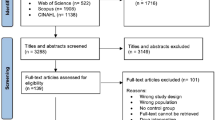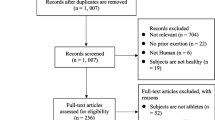Abstract
Objective
To review and assess the effect of single moxibustion for exercise-induced fatigue: (EIF).
Methods
Computer-search for 8 medical databases and 5 clinical trail registries were conducted for: randomized controlled trials (RCTs), added with hand-search for 10 Chinese acupuncture-moxibustion journals and additional references. Data from included RCTs were pooled by RevMan5.1. Methodology quality of RCTs was judged by Cochrane Collaboration assessment tool while quality of primary outcomes was evaluated by GRADE3.2.
Results
Five RCTs were finally included, all reported in small sample size with high risk of: bias. Comparisons on single moxibustion and rest relief (without treatment) were studied. Six outcomes were reported, all favored moxibustion to rest relief for EIF. Primary outcomes showed as rating of perceived exertion (RPE) with mean difference (MD)=−0.49, 95% confidence interval (CI) [−0.80, −0.19], 800-m race performance with MD=−2.21, 95% CI [−3.57, −0.85], and Harvard Step Index (HSI) with MD=14.75, 95% CI [8.35, 21.15]. Moreover, all primary outcomes as RPE, 800-m race performance and HSI were rated low quality.
Conclusions
Single moxibustion might be considered effective for EIF. However, due to small samples of included RCTs, high risk of bias among studies and poor quality of primary outcomes and subjects restricted to Chinese athletes only, these results present limitation, and should be taken with caution for practice. More large-size studies with rigorous design are warranted to further test effectiveness of moxibustion for EIF.
Similar content being viewed by others
References
Knuttgen HG, Vogel JA, Poortmans J, eds. Biochemistry of exercise. Champaign, IL., USA: Human Kinetics Publishers; 1983:121–130.
Edwards RHT. Biochemical bases of fatigue in exercise performance: catastrophe theory of muscular fatigue. In: Knuttgen HG, Vogel JA, Poortmans J, eds. Biochemistry of exercise. Champaign, IL., USA: Human Kinetics Publishers; 1983:3–28.
Guo J. Overtraining of endurance athletes. J Beijing Teach Coll Phys Edu (Chin) 1994;6:99–104.
Pan TB. Physiological analysis of overtraining syndrome. Sports Sci Res (Chin) 1997;18:33–36.
Budgett R. Fatigue and underperformance in athletes: the overtraining syndrome. Br J Sports Med 1998;32:107–110.
Available from: http://www.fims.org/ (Accessed at 2014 Jan 20).
Available from: http://www.olympic.org/ (Accessed at 2014 Jan 20).
Available from: http://www.iaaf.org/home (Accessed at 2014 Jan 20).
Pan TB. Exercise-induced fatigue and its recovery process. In: Wang BB, Hua M, eds. Exercise physiology. Beijing, China: Higher Education Press; 2006:317–329.
Yang Y, Li ZH, eds. Exercise-induced fatigue, its prevention and treatment. Beijing: Beijing Sport University Press; 2008:86, 88–141.
Sun GJ, ed. Science of acupuncture and moxibustion. Beijing: People’s Medical Publishing House; 2011:501–513.
Lan L, Chang XR, Shi J, Zhang GS, Tan J. Advances of the mechanism of moxibustion. China Arch Tradit Chin Med (Chin) 2011;29:2616–2620.
Xu HF, Zhao BX. Brief introduction on effect mechanism of moxibustion therapy. Proceedings of Annual Conference of China Association of Acupuncture and Moxibustion (CAAM). 2011:459–467.
Kim SY, Chae Y, Lee SM, Lee Hy, Park HJ. The effectiveness of moxibustion: an overview during 10 years. Evid Based Complement Alternat Med 2011;2011:306515.
Ernst E, Lee MS. A trial design that generates only “positive” results. J Postgrad Med 2008;54:214–216.
Kim TH, Choi TY, Shin BC, Lee MS. Moxibustion for managing type 2 diabetes mellitus: a systematic review. Chin J Integr Med 2011;17:575–579.
Tian Y, ed. Advanced physiology of sport and exercise. Beijing: Higher Education Press; 2003:366–395, 452–477.
Guyatt G, Oxman AD, Akl EA, Kunz R, Vist G, Brozek J, et al. GRADE guidelines: 1. Introduction: GRADE evidence profiles and summary of findings tables. J Clin Epidemiol 2011;64:383–394.
Chen YL, Yao L, Norris S, Du L, Chen H, Zeng XT, et al. Application of GRADE in systematic reviews: necessity, frequently-asked questions and concerns. Chin J Evid Based Med (Chin) 2013;13:1401–1404.
Liu CG, Bao XT. Therapeutic observation of moxibustion in releasing exercise-induced fatigue. Shandong Sports Sci Tech (Chin) 2010;32:21–23.
Gu YH, Jin HZ, Wu YC, Shi SS. Clinical study on moxibustion for serum NO and NOS after sports. Modern Tradit Chin Med (Chin) 2006;26:1–3.
Tao SG. Study on functions of non-pain moxibustion therapy and anti-motor fatigue [dissertation]. Changchun: Northeast Normal University; 2006.
Wang XD. Clinical research on acupuncture and moxibustion preventing and treating exercise-induced fatigue [dissertation]. Ji’nan: Shandong University of Traditional Chinese Medicine; 2005.
Shi SS. Effect of moxibustion on blood lactic acid during exercise. Shanghai J Acupunct Moxibust (Chin) 2002;21:20–21.
Li YP, ed. Evidence-based medicine. Beijing, China: Higher Education Press; 2009:80–81, 204–206.
MacPherson H, White A, Cummings M, Jobst K, Rose K, Niemtzow R. Standards for reporting interventions in controlled trials of acupuncture: the STRICTA recommendations. Complement Ther Med 2001;9:246–249.
MacPherson H, Altman DG, Hammerschlag R, Li YP, Wu TX, White A, et al. Revised standards for reporting interventions in clinical trials of acupuncture (STRICTA): extending the CONSORT statement. PLoS Med 2010;7:e1000261.
Park JE, Lee SS, Lee MS, Choi SM, Ernst E. Adverse events of moxibustion: a systematic review. Complement Ther Med 2010;18:215–223.
Available from: http://en.wikipedia.org/wiki/Borg_scale (Accessed at 2013 Dec11).
Perceived Exertion (Borg Rating of Perceived Exertion Scale). Available from: http://www.cdc.gov/physicalactivity/everyone/measuring/exertion.html (Accessed at 2013 Dec 11).
Li W, Zhang YF, Zhang L, Li ZZ. The research of the sport burden grade standard corresponding to the heart rate. Natural Sci J Harbin Normal Univ (Chin) 2008;24:99–102.
Chalder T, Berelowitz G, Pawlikowska T, Watts L, Wessely S, Wright D, et al. Development of a fatigue scale. J Psychosom Res 1993;37:147–153.
Cella M, Chalder T. Measuring fatigue in clinical and community settings. J Psychosom Res 2010;69:17–22.
Hewlett S, Dures E, Almeida C. Measures of fatigue. Arthrit Care Res 2011;63:S263–S286.
Zhang R. Syndrome characteristics and molecular biology mechanisms of change in learning and memory capacity caused by sports fatigue [dissertation]. Beiing: Beijing University of Chinese Medicine; 2008.
Guo XF, Lai SL, Liang WX. Selection and application of outcomes in clinical effect appraisal for traditional Chinese medicine. J Guangzhou Univ Tradit Chin Med (Chin) 2002;19:251–255.
National standard for student health and fitness. Available from: http://www.sport.gov.cn/n16/n1092/n16879/n17321/1440735.html (Accessed at 2014 March 1).
Shen GQ, Zhou YP, Wang J. Research advancement in step test. Zhejiang Sport Sci (Chin) 2003;25:19–21.
Fang GX. Step test status and development trend of study. J Tongling Coll (Chin) 2011;12:122–124.
Feng C. Diagnosis for exercise-induced hemoglopenia and exerciseinduced anemia in middle- and long-distance runners and discussion on its nutrition recovery. Track Field (Chin) 2004;25:56–57.
Available from: http://en.wikipedia.org/wiki/Lactic_acid (Accessed at 2014 March 6).
Xiong Y, Gu YH, Wu YC. Effect of moxibustion on Hb, CK, etc. in female weigh-lifters and Judokas during pre-competition weightcontrol period. Jiangsu J Tradit Chin Med (Chin) 2013;45:53–55.
Zhang XL, Huang LY. Clinical observation on intervention of moxibustion over Zusanli for exercise-induced fatigue. Nei Mongol J Tradit Chin Med (Chin) 2013;32:28–29.
Li XL. Experiment study on anti-sport moxibustion over Yongquan, Zusanli and Guanyuan against sports fatigue for training rats [dissertation]. Xi’an: Shaanxi Normal University; 2009.
Hua Y, Liu B, Zhang KB. Effects of applying moxibustion at Zusanli and Guanyuan acupoints on rats’ exercise endurance and anti-oxidant injury of kidney tissue. Chin J Rehabil Med (Chin) 2012;13:1036–1040.
Zhao JG, Li JW, Wang MY, Ding M. Study on the correlations among the blood free oxygen radicals, blood lactate, RPE, heart rate and exercise intensity. J Shenyang Institute Phys Educ (Chin) 2004;23:360–362.
Li TH. Effects of preconditioning moxibustion on blood pressure and heart rates of post-exercise. Bull Sport Sci Tech (Chin) 2009;17:122–124.
Jia TQ, Chang LY, Song JL, Hong WX, Fan FJ. Study of moxibustion for sport fatigue recovery. J Beijing Sport Univ (Chin) 2006;29:1529–1531.
Ge TY, Liu LP. Effect of acupuncture and moxibustion in preventing and treating exercise fatigue. J Hebei Inst Phys Educ (Chin) 2011;25:85–88.
Vickers A, Goyal N, Harland R, Rees R. Do certain countries produce only positive results? A systematic review of controlled trials. Control Clin Trials 1998;19:159–166.
Author information
Authors and Affiliations
Corresponding author
Rights and permissions
About this article
Cite this article
Zhong, Dk., Tang, D., Xue, L. et al. Effectiveness of moxibustion for exercise-induced fatigue—A systematic review for randomized controlled trials. Chin. J. Integr. Med. 22, 130–140 (2016). https://doi.org/10.1007/s11655-014-1849-8
Received:
Published:
Issue Date:
DOI: https://doi.org/10.1007/s11655-014-1849-8




